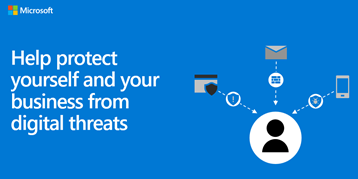Protect yourself against phishing and other attacks
In addition to the protection Microsoft 365 Business Premium offers against attacks, there are other measures all members must take to defend the organization. Make sure everyone understands the following concepts:
- Spam or junk mail. There are many reasons you might receive junk e-mail and not all junk mail is the same. However, you can reduce what gets through to you, and thus reduce the risks of attacks, by filtering out junk mail.
- Phishing. A phishing scam is an email that seems legitimate but is an attempt to get your personal information or steal your money.
- Spoofing. Scammers can also use a technique called spoofing to make it appear as if you've received an email from yourself.
- Malware is malicious software that can be installed on your computer after you've selected a link or opened a document from an email. There are various types of malware (for example, ransomware, when your computer is taken over), but you don't want to have any of them.
Best practices
Use the following best practices to help users fend off cyberattacks through email.
Reduce spam mail
Follow these 10 tips on how to help reduce spam.
Report it
Report any phishing or other scam emails you receive. Select the message, and choose Report message on the ribbon.
For more information, see reporting junk and phishing emails.
Avoid phishing
- Never reply to an email that asks you to send personal or account information.
- If you receive an email that looks suspicious or asks you for this type of information, never select links that supposedly take you to a company website
- Never open any file attached to a suspicious-looking email.
- If the email appears to come from a company, contact the company's customer service via phone or web browser to see if the email is legitimate.
- Search the web for the email subject line followed by the word hoax to see if anyone else has reported this scam.
Read about five common types of scams in Deal with abuse, phishing, or spoofing.
Make sure your emails look legitimate to others
Help your customers trust your communications by adding a digital signature to prove that it's coming from you. See Secure messages by using a digital signature.
Share this infographic with your users
Download this infographic with tips for you and the members of your campaign team or business:
Learn more about how to:
Next step
Learn how to send encrypted email.
Feedback
Coming soon: Throughout 2024 we will be phasing out GitHub Issues as the feedback mechanism for content and replacing it with a new feedback system. For more information see: https://aka.ms/ContentUserFeedback.
Submit and view feedback for
